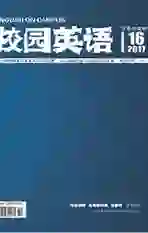Human Translator and Translation Technology
2017-07-13LuChanyu
Lu+Chanyu
【Abstract】The comparison between human translator and translation technology, whether the latter will completely replace the former has been heated debate for many years. This essay intends to make a comparison between human translator and translation technology and illustrate both merits and demerits with translation examples
【Key words】human translator; translation technology; CAT
Thank to various kinds of electronic dictionaries and software researched and developed recently, a number of translation-specific software systems have migrated from main frame to PC platforms(Healther Fulford & Joaquin Granell-Zafra, 2005, p.2), people could translate source texts increasingly time-saving than before. Then we say good-bye to those “once upon a time, translators worked on source texts, perhaps with the aid of a dictionary (Jose Ramon Biau Gil & Anthony Pym, p.8)” days.
Actually, the issue of translation technology did not enjoy global scholars attention until the first idea—using computer to process automatic language translation, which was put forward by Commissioner of the Rockefeller foundation of natural science Warren Weaver and British engineer A·D Booth in 1940s.
Translation technologies, including machine translation, alignment, translation memory (a linguistic database that captures translations as you work for future use) etc. and also several CAT tools, such as trados, Déjà vu, Snowman etc. Through reading the references, one sentence strike me most, as “Technology extends human capacities” (Jose Ramon Biau Gil & Anthony Pym, p.1). This not only involves living up to the demands set by the product life cycles but also to find solutions satisfying additional internal needs.(Jennifer A. Brundage, p.1). The factor that Increasing translation service need promotes the development of translation technology field, which was put forward by Jose & Anthony can also be seen as an internal need. Jennifer also introduce NLP (natural language processing), which is a field of computer science, artificial intelligence, and linguistics concerned with the interactions between computers and human(natural) languages as another evolution of translation technology.
According to Heather & Joaquins theory, freelance translators activities are always aided by ICT support. H& J pointed out that “those who had adopted translation tools were generally positive about the benefits they were deriving from their use” (p.11).
J&A argue that “electronic communications make it relatively easy to distribute very large translation jobs between various intermediaries” (Jose Ramon Biau Gil & Anathony Pym, p.3), and “MT systems produce high quality translations” (p.13).
The positive attitude towards translation technology, the three references share in common. While, only one discusses about advantages and disadvantages for translators. J&A restated their position that “the way to advance within the profession usually involves more conceptual control over technology.”.
I can still recall what my professor used to tell me that the most advantage is we human being can do “adjustment and judgement”. Human translator can be flexible. People could precisely deal with rhetorical device.
Translation technology also promotes the development of our society. It significantly improved the efficiency of translation. With the help of translation memory, most work done automatically is always literal translation. From this point of view, I hold the point that translation technology could only aid our human translation; they cannot replace the position of human translation. As we are getting wider use of a translation machine, we need to try our best to perfect the softwares function. We need to better combine technology and human translation, and let the translation assist our human translator.
References:
[1]Heather Fulford and Joaquin Granell-Zafra.(2005).Translation and Technology:A Study of UK Freelance Translators.UK: Bussiness School,Loughborough University.
[2]Jose Ramon Biau Gil and Anthony Pym.Technology and translation(a pedagogical overview).Spain:Intercultural Studies Group,Universitat Rovirai Virgli Tarragona.
[3]Jennifer A.Brundage.(2011).Machine Translation-Evolution not revolution.Germany:SAP AG P.O.Box 1461,D-69185 Walldorf.
作者簡介: 陆潺予(1991-),女,黑龙江伊春人,文学硕士,专业: 电脑辅助翻译,职位: 星海音乐学院国际交流合作处,主要研究方向: 翻译理论。
